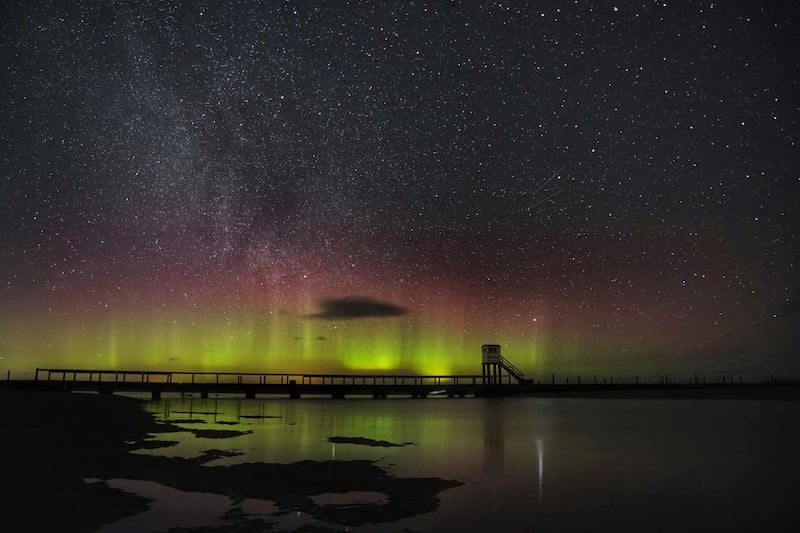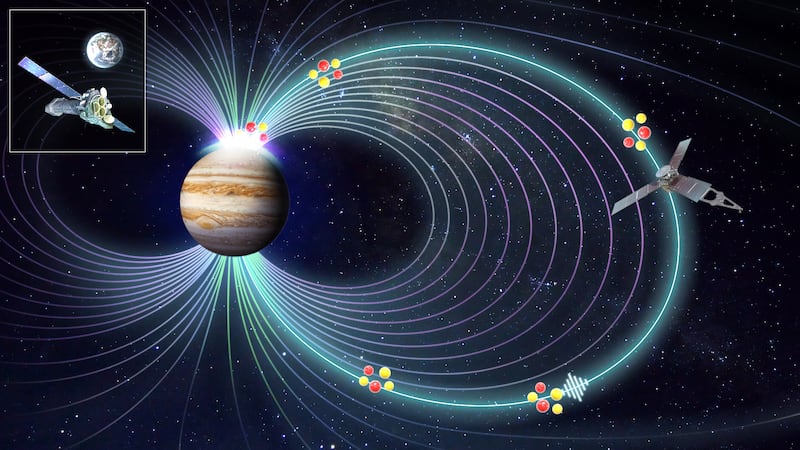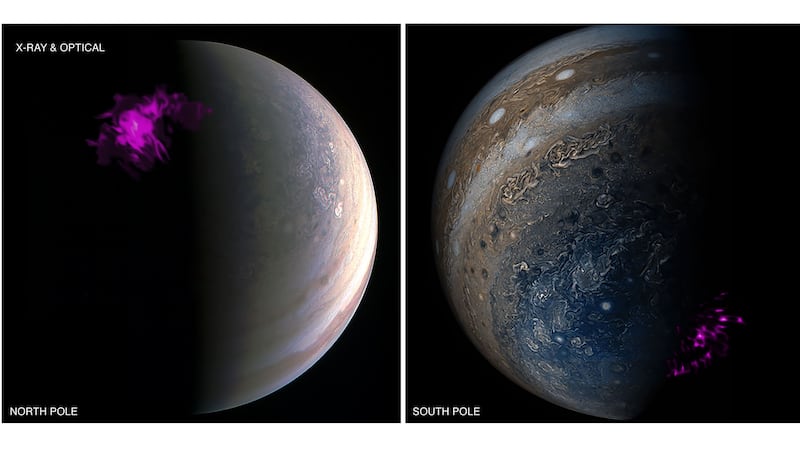The decades-old mystery of how Jupiter produces a burst of X-rays every few minutes has been solved by scientists.
The X-rays are part of the giant planet’s aurora – bursts of visible and invisible light that occur when charged particles interact with the planet’s atmosphere.
While a similar phenomenon occurs on Earth, creating the northern lights, Jupiter’s is much more powerful.
It releases hundreds of gigawatts of energy, enough to briefly power all of human civilisation, researchers say.
Researchers combined close-up observations of Jupiter’s environment by Nasa’s satellite Juno, which is currently orbiting the planet, with simultaneous X-ray measurements from the European Space Agency’s XMM-Newton observatory (which is in Earth’s own orbit).
The team discovered that X-ray flares were triggered by periodic vibrations of Jupiter’s magnetic field lines.
These vibrations create waves of plasma (ionised gas) that send heavy ion particles “surfing” along magnetic field lines until they smash into the planet’s atmosphere, releasing energy in the form of X-rays.
Co-lead author Dr William Dunn, UCL Mullard Space Science Laboratory, said: “We have seen Jupiter producing X-ray aurora for four decades, but we didn’t know how this happened.
“We only knew they were produced when ions crashed into the planet’s atmosphere.
“Now we know these ions are transported by plasma waves – an explanation that has not been proposed before, even though a similar process produces Earth’s own aurora.

“It could, therefore, be a universal phenomenon, present across many different environments in space.”
The planet’s X-ray auroras are at its north and south poles, often with clockwork regularity.
During the study observation Jupiter was producing bursts of X-rays every 27 minutes.
According to the study published in Science Advances, the charged ion particles that hit the atmosphere originate from volcanic gas pouring into space from giant volcanoes on Jupiter’s moon, Io.
This gas becomes ionised – its atoms are stripped free of electrons – due to collisions in Jupiter’s immediate environment, forming a doughnut of plasma that encircles the planet.
Co-lead author Dr Zhonghua Yao, Chinese Academy of Sciences, Beijing, said: “Now we have identified this fundamental process, there is a wealth of possibilities for where it could be studied next.

“Similar processes likely occur around Saturn, Uranus, Neptune and probably exoplanets as well, with different kinds of charged particles ‘surfing’ the waves.”
For the new study, researchers led by UCL and the Chinese Academy of Sciences analysed observations of Jupiter and its surrounding environment, carried out continuously over a 26-hour period by the Juno and XMM-Newton satellites.
They found a clear correlation between waves in the plasma detected by Juno and X-ray auroral flares at Jupiter’s north pole recorded by X-MM Newton.
The experts then used computer modelling to confirm that the waves would drive the heavy particles towards the planet’s atmosphere.
However, why the magnetic field lines vibrate periodically is unclear.
Researchers suggest the vibration may result from interactions with the solar wind or from high-speed plasma flows within Jupiter’s magnetosphere.
Jupiter’s magnetic field is extremely strong – about 20,000 times as strong as Earth’s – and therefore its magnetosphere, the area controlled by this magnetic field, is extremely large.
If it was visible in the night sky, it would cover a region several times the size of our moon.
The work was supported by the Chinese Academy of Sciences, the National Natural Science Foundation of China, and the UK’s Science and Technology Facilities Council (STFC), Royal Society, and Natural Environment Research Council, as well as ESA and Nasa.








